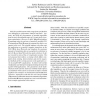Free Online Productivity Tools
i2Speak
i2Symbol
i2OCR
iTex2Img
iWeb2Print
iWeb2Shot
i2Type
iPdf2Split
iPdf2Merge
i2Bopomofo
i2Arabic
i2Style
i2Image
i2PDF
iLatex2Rtf
Sci2ools
IPPS
1997
IEEE
1997
IEEE
A Tool for On-line Visualization and Interactive Steering of Parallel HPC Applications
Tools for parallel systems today range from specification over debugging to performance analysis and more. Typically, they help the programmers of parallel algorithms from the early development stages to a certain level of program optimization. However, in HPC (High Performance Computing) today the end-user of massively parallel CFD (Computational Fluid Dynamics)-programs has little or no support in his work. The scientific engineer who often runs his application on a parallel computer somewhere in the WAN (Wide Area Network) and visualizes the enormous amounts of simulation data on a graphical workstation in his LAN (Local Area Network) has needs which are by far not covered by state of the art visualization systems. The tool proposed here follows a strategy which differs completely from existing, batch-oriented, and strictly sequential methods of the working process in the application cycle of parallel HPC applications. It allows both on-line visualization and interactive program ...
Distributed And Parallel Computing | IPPS 1997 | Massively Parallel | Parallel Hpc Applications | Parallel Numerical Simulation |
| Added | 06 Aug 2010 |
| Updated | 06 Aug 2010 |
| Type | Conference |
| Year | 1997 |
| Where | IPPS |
| Authors | Sabine Rathmayer |
Comments (0)

